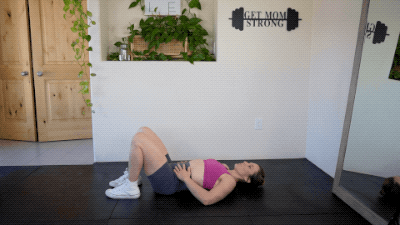Although not everyone with diastasis recti symptoms has back pain, a lot of people do. And with the rigors of mom life, back pain can make you miserable. Mom life requires constant lifting. From picking up a car seat, carrying a toddler through the zoo, or bringing in the groceries in one trip, you need your core to help support your back.
Let’s talk about what may cause back pain postpartum, and more importantly–how to fix it.
Diastasis Recti and Back Pain
Throughout pregnancy, the connective tissue that runs between your six-pack muscles thins and widens to accommodate weight gain and the growing baby. This abdominal separation, also known as diastasis recti, can leave your core feeling weak long after baby has arrived. As a result of this core weakness, other muscles try to compensate for the lack of core stability. A major muscle compensation pattern is over-recruitment of the low back muscles and gripping your glutes tight. Any muscles that are overworked, are likely to become tight and angry, causing pain.
While studies show back pain isn’t a sign of diastasis recti, many women with diastasis recti also have back pain. Essentially, a weak core leads to back pain. It’s a vicious cycle, but there are treatment options!
Postpartum Back Pain Relief
Strengthening your core and pelvic floor will make a BIG difference. Think of your transverse abdominis muscles like a natural corset, supporting your body. (Side note: actual corsets are crap!) Over the course of a pregnancy, this corset system – along with the connective tissue and linea alba – stretch, and your body loses some of its “mind-muscle connection”.
To help with back pain, you will need to re-learn that connection and how to use your deep core muscles to support your body. When the deep core is strong, your back muscles can let go, bringing pain relief.
Breathing to Help Back Pain
Proper breathing is key to regaining the mind-body connection, which can help with back pain relief. Often called diaphragmatic breathing or deep belly breathing, this is one of the most important healing tips I teach clients, and it’s the first thing you’ll learn in my Core Basics program.
Diaphragmatic Breathing
- Relax in a seated or side-lying position with one hand on your chest, the other on your lower ribcage.
- Take a slow, deep breath in through your nose and feel your ribs expand open like an umbrella. (Your chest and shoulders should remain mostly still.)
- Exhale through your mouth, pulling your abdominals in and up. Think belly button to spine AND up toward sternum. Again, you are keeping the chest mostly still.
Practice this for five minutes daily to restore mind-muscle connection with your deep core and pelvic floor.
Also, incorporate diaphragmatic breathing into your daily life when you lift things. For example, as you prepare to pick up your kids, groceries, etc., inhale deeply through your nose. As you lift, make a big exhale through your mouth, lift pelvic floor, and draw belly in and up. This fires up your body’s natural back brace, so you can safely lift heavy loads.
If you are just sitting on your couch though, don’t hold your core tight. Relaxation of the core and pelvic floor is also important.
Exercises to Help Back Pain and Diastasis Recti
You don’t necessarily need to head straight to physical therapy for back pain. (But I always encourage seeking help from a medical professional if the pain is unmanageable.) A pelvic floor physical therapist, in particular, can really help get to the root of the problem.
Use the following exercises to regain strength in your ab muscles and alleviate back pain. Make sure to use diaphragmatic breathing as you complete each one:
Pelvic Tilts

- Lie on your back, with your feet on the ground and legs bent at a 90 degree angle.
- Inhale through your nose, down into your ribcage.
- Exhale audibly out your mouth while you gently tilt your pelvis
Bird Dogs

- Get on all fours, with your hands under your shoulders, hips and knees aligned.
- Inhale down into body as you gently let your tummy relax and you look up and lift your left arm and right leg.
- Exhale out your mouth as you extend opposite arm and opposite leg. Be sure to keep a neutral spine. Alternate arms and legs.
Cat/Cow

- Get on all fours, with your hands under your shoulders, hips and knees aligned.
- Inhale through your nose into your body as you let your tummy relax, looking toward the ceiling.
- Exhale audibly as you press your palms into the floor, arch back, and tuck pelvis.
Bridges

- Lie on your back, with your feet on the ground and legs bent at a 90 degree angle.
- Inhale through your nose down into your body while your back is on the ground.
- Exhale out your mouth as you rise, lifting your butt off the ground and squeezing your glute at the top. (Don’t overextend at the top or arch your back!)
- As you relax down, inhale and reset.
Lying Marches

- Lie on your back, with your feet on the ground and legs bent at a 90 degree angle.
- Inhale through your nose while your feet are on the ground.
- Exhale through your mouth and lift your pelvic floor as you draw your knee in toward your chest.
- Alternate raising/lowering your legs.
The Bottom Line
Back pain and diastasis recti are frustrating. But working through these and other exercises can help you regain the core strength you need to meet the physical demands of daily mom life.
